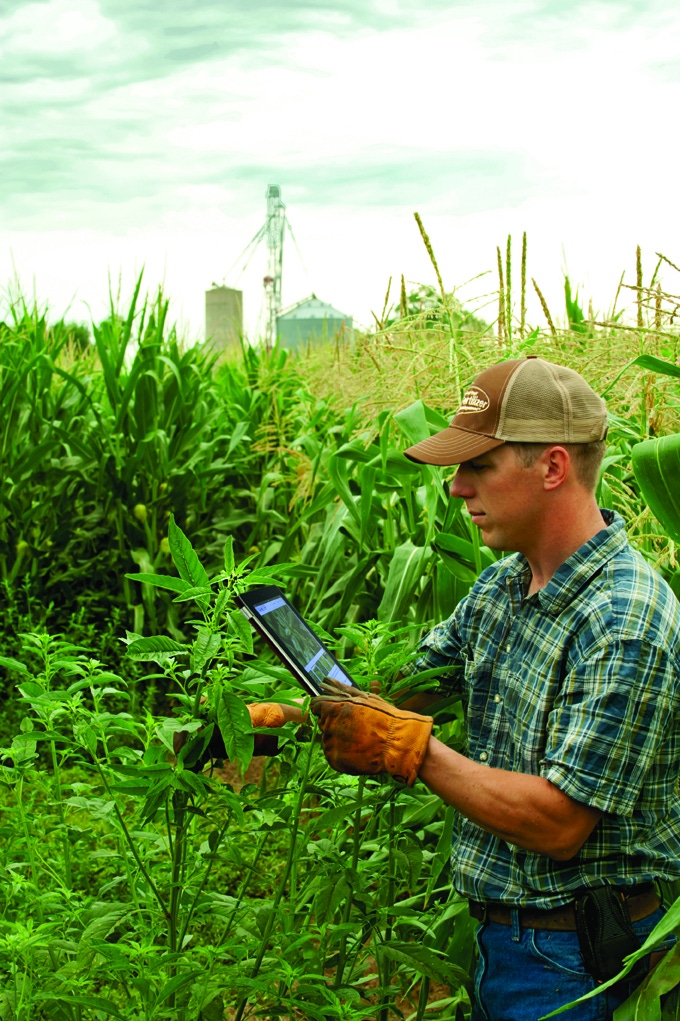
As part of A to Z Week, Farm Industry News is launching the A to Z alphabet of technologies changing agriculture. We are launching sections of the ag alphabet throughout this week. Check back here for additions.
New technologies in agriculture have automated many tasks on the farm, making crop production more efficient and profitable. Farm Industry News editors poured over the newest high-tech products and services that are changing the face of agriculture to bring readers a glimpse of the future of farming.
Compare and contrast this 2013 list to the last time we published A to Z in 2008. See how technology has changed in just five years.
A, B, C
A
Advanced biofuels
In the future, farmers will grow more than just corn to produce advanced biofuels. This new classification of fuels is 2nd and 3rd generation biofuels, which reduce greenhouse gas emissions by 50% compared to gasoline or diesel produced in 2005. Corn ethanol is not considered an advanced biofuel. Instead, fuels like biodiesel made from soybean oil and ethanol made from Brazilian sugarcane are classified as advanced biofuels.
The Advanced Biofuels Association reports that many products from advanced biofuels will be hydrocarbon-based molecules that are interchangeable and will not require separate pumps, pipelines, or new flex fuel cars. The advanced biofuels and products include biodiesel-ester, biogas, butanol, ethanol, renewable crude oil, renewable diesel-hydrocarbon, renewable jet fuel and renewable gasoline. -Lynn Grooms
More on biofuels:
Apps The plethora of agricultural apps available on tablets and mobile devices is a testament to farmers' quick adoption of mobile and tablet technology. There are apps available to farmers for checking commodity prices, monitoring the weather, planning optimum seeding rates, navigating their way through farm shows, managing data from the cab, mapping field boundaries, soil sampling, and much more. -Kathy Huting
The plethora of agricultural apps available on tablets and mobile devices is a testament to farmers' quick adoption of mobile and tablet technology. There are apps available to farmers for checking commodity prices, monitoring the weather, planning optimum seeding rates, navigating their way through farm shows, managing data from the cab, mapping field boundaries, soil sampling, and much more. -Kathy Huting
More on apps:
Autonomous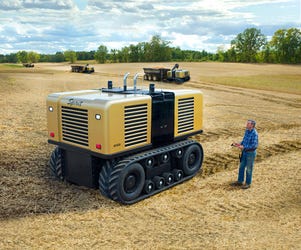 Five years ago we predicted the introduction of autonomous tractors and we were right. Today, two companies have introduced vehicles that drive without human operators. Kinze Manufacturing introduced their Autonomous Harvest System where the tractor/grain cart runs between the combine and unloading site without an operator. The tractor is outfitted with sensors, cameras, radar, GPS and guidance equipment to safely navigate through the field. The combine operator oversees it and issues commands to the tractor. The Autonomous Tractor Corp. unveiled its prototype Spirit tractor with tracks and no cab. The Spirit operates with a laser and radio navigation system and is designed low-cost, efficient and reliable. Watch for updates on these two systems along with newcomers to the technology. -Karen McMahon
Five years ago we predicted the introduction of autonomous tractors and we were right. Today, two companies have introduced vehicles that drive without human operators. Kinze Manufacturing introduced their Autonomous Harvest System where the tractor/grain cart runs between the combine and unloading site without an operator. The tractor is outfitted with sensors, cameras, radar, GPS and guidance equipment to safely navigate through the field. The combine operator oversees it and issues commands to the tractor. The Autonomous Tractor Corp. unveiled its prototype Spirit tractor with tracks and no cab. The Spirit operates with a laser and radio navigation system and is designed low-cost, efficient and reliable. Watch for updates on these two systems along with newcomers to the technology. -Karen McMahon
More on Autonomous:
B
Big Data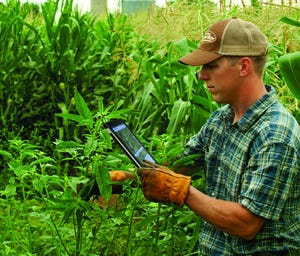 Big Data is the buzzword used to describe the massive amounts of information being collected and stored on all of us. On the farm, this data may include crop yield history, product usage, order status, payment history, vehicle status, and field data such as soil types, moisture levels, available nutrients, pest pressures, and weather—all tied to a geo-referenced dot on a map.
Big Data is the buzzword used to describe the massive amounts of information being collected and stored on all of us. On the farm, this data may include crop yield history, product usage, order status, payment history, vehicle status, and field data such as soil types, moisture levels, available nutrients, pest pressures, and weather—all tied to a geo-referenced dot on a map.
These mounds of data have become big business for companies, ready to step in to store, manage and analyze the information for the end purpose of helping farmers make better business decisions. Faster processing speeds, Cloud-based storage, and advanced analytics are giving rise to these tools, moving us from an era of precision data to decision data.
Farmers, who have been historically private about their business affairs, are giving companies access to their information out of survival, knowing that the stockpiles of information will be used to take the guesswork out of producing a crop. -Jodie Wehrspann
More on big data:
Biologicals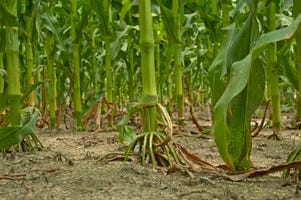 The global market for biologicals is between $1.4 billion and $1.6 billion and is projected to grow to approximately $3 billion by 2020, according to the industry analysis firm Frost & Sullivan. While there is confusion over the product category itself, which includes biorationals, biostimulants and biopesticides, there is no doubt it will grow. More biological products are being incorporated into conventional corn and soybean farming as part of a pest management and/or plant health program. -Lynn Grooms
The global market for biologicals is between $1.4 billion and $1.6 billion and is projected to grow to approximately $3 billion by 2020, according to the industry analysis firm Frost & Sullivan. While there is confusion over the product category itself, which includes biorationals, biostimulants and biopesticides, there is no doubt it will grow. More biological products are being incorporated into conventional corn and soybean farming as part of a pest management and/or plant health program. -Lynn Grooms
More on biologicals:
Brown revolution
There’s nothing like a $15,000/acre price tag to spark interest in building a land’s fertility, which has spawned the “Brown Revolution.” First reported in our sister publication Corn & Soybean Digest in January, the Brown Revolution refers to soil as a factory for increasing yields. Research for the Brown Revolution focuses on soil microbes that convert sunlight, water, CO2 and crop residue into crop yields. Factors that play into this are moisture, nutrients, crop residue, tillage practices and pest control. In other words, it’s all about getting your soil in top condition to produce top yields. -Karen McMahon
More on brown revolution
C
CAN bus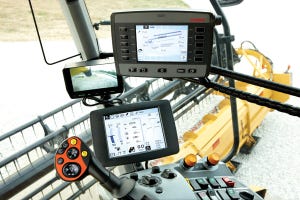 Controller area network, called CAN bus for short, is an integrated electronics network that originated in the auto industry. It allows multiple controllers to exchange information on a single circuit or “bus,” allowing for such things as raising and lowering all four windows of a car. The same technology now dominates farm machinery to automate complex sequences such as turning a tractor and raising an implement at end rows.
Controller area network, called CAN bus for short, is an integrated electronics network that originated in the auto industry. It allows multiple controllers to exchange information on a single circuit or “bus,” allowing for such things as raising and lowering all four windows of a car. The same technology now dominates farm machinery to automate complex sequences such as turning a tractor and raising an implement at end rows.
One of the most recent applications is Claas’s Cemos Automatic, displayed this year at the international trade show SIMA in Paris, where it won a gold medal. The control system, designed for its Lexion combines, takes over the task of applying the correct sieve, fan and separator settings in place of an operator. -Jodie Wehrspann
More on CAN bus
Cloud computing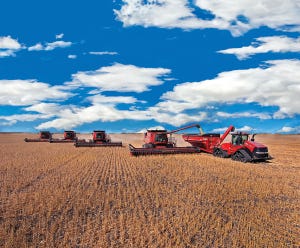 Accessing remote computing resources through the internet – so-called cloud computing – is becoming commonplace in agriculture. Powered by wireless connectivity, typically through cellular modems, cloud computing capabilities make it possible to eliminate the frustration of shuffling thumb drives to keep precision ag data up to date. Cloud-based precision software options provide any-time, any-where data access. Linking to high-powered computers and sophisticated software promises to streamline decision-making by making information available to key farm management players. -David Hest
Accessing remote computing resources through the internet – so-called cloud computing – is becoming commonplace in agriculture. Powered by wireless connectivity, typically through cellular modems, cloud computing capabilities make it possible to eliminate the frustration of shuffling thumb drives to keep precision ag data up to date. Cloud-based precision software options provide any-time, any-where data access. Linking to high-powered computers and sophisticated software promises to streamline decision-making by making information available to key farm management players. -David Hest
More on cloud computing:
D, E, F
D
Drought tolerance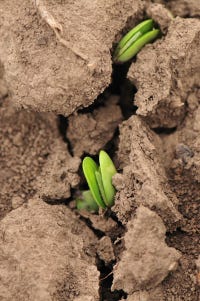 The 2012 drought was the perfect time for companies to test new drought-tolerant corn hybrids. For example, Syngenta reported a 17% advantage with its Agrisure Artesian trait under extreme drought conditions in last year’s field trials.
The 2012 drought was the perfect time for companies to test new drought-tolerant corn hybrids. For example, Syngenta reported a 17% advantage with its Agrisure Artesian trait under extreme drought conditions in last year’s field trials.
The drought-tolerant hybrids will be vital for maintaining yields this year as the drought lingers in many areas. But companies are racing to meet demand. Monsanto's Genuity DroughtGard corn hybrids are now available to farmers in the Western Great Plains through a stewarded commercial introduction. The product was developed in cooperation with BASF.
DuPont Pioneer is doubling the acres on which its Optimum Aquamax drought-tolerant hybrids are planted this year compared to 2012. Optimum Aquamax corn leaves are slower to roll in water-limited environments.
While the focus has been on drought-tolerant corn, drought-tolerance research is being conducted in soybeans, too. At a recent media event, DuPont Pioneer representatives said the company is working on drought-tolerant soybeans by using its proprietary Accelerated Yield Technology and by leveraging its Aquamax technology in corn. But a commercial release of a drought-tolerant soybeans is not yet planned. -Kathy Huting
More on drought tolerance:
E
Electric-driven motors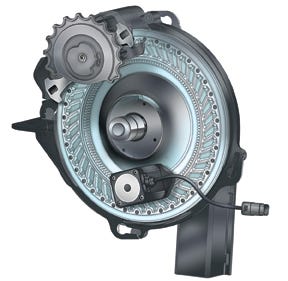 There are three forms of tractor power: mechanical, hydraulic, and electrical. Agricultural engineers are studying how to exploit those forms of tractor power to improve efficiencies of the tractor implement system. “With tractors, we are always looking to get the most power out of it — whether it be ground power, hydraulic, or PTO power — for the amount of money we spend to create it or for the fuel required to run it,” says Douglas Otto, engineer with CNH and program chair of the American Society of Agricultural and Biological Engineers (ASABE). “Because of that, additional research is being done on mechanical power, and whether it is the most efficient way, or if there is another way that would be more efficient.”
There are three forms of tractor power: mechanical, hydraulic, and electrical. Agricultural engineers are studying how to exploit those forms of tractor power to improve efficiencies of the tractor implement system. “With tractors, we are always looking to get the most power out of it — whether it be ground power, hydraulic, or PTO power — for the amount of money we spend to create it or for the fuel required to run it,” says Douglas Otto, engineer with CNH and program chair of the American Society of Agricultural and Biological Engineers (ASABE). “Because of that, additional research is being done on mechanical power, and whether it is the most efficient way, or if there is another way that would be more efficient.”
For example, he says operations that require a variable-speed drive, like planting or spraying, have historically been powered by hydraulics. “Some studies have shown that electrical power is a cheaper way to go,” Otto says.
Planter manufacturers including Horsch, Kinze and Precision Planting all came out this year with electric-motor-driven seed meters. The companies claim seed meters driven by electric motors result in better seed placement and faster planting speeds than what is offered by mechanical systems that use chains and sprockets. -Jodie Wehrspann
More on electric drive
Article: Electric variable-rate planting from an entrepreneur
Horsch planter advances electric-drive technology
Video: Kinze electric seed meters explained at National Farm Machinery Show
Video: Monsanto, Precision Planting produce FIeldScripts for variable planting control
F
FMIS - Farm management information systems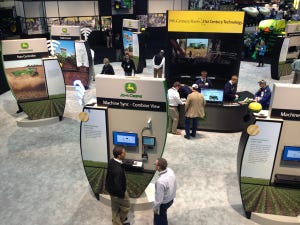 Precision farming is going beyond GPS-based field guidance and control systems. Now it is integrated with accounting software programs called farm management information systems (FMIS) to help farmers manage their business. Such systems include geo-referenced records management, business planning, cash flow projections, systems decision making, and equipment utilization.
Precision farming is going beyond GPS-based field guidance and control systems. Now it is integrated with accounting software programs called farm management information systems (FMIS) to help farmers manage their business. Such systems include geo-referenced records management, business planning, cash flow projections, systems decision making, and equipment utilization.
Many manufacturers offer these data management solutions. Examples include CLAAS’s Farm Management System and John Deere’s FarmSight strategy. The Agricultural Industry Electronics Foundation (AEF) is working to develop compliance standards that will ensure that data collected can be shared across the different platforms. -Jodie Wehrspann
More on FMIS
G, H, I
G
Genome sequencing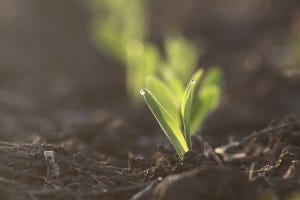 Seed companies now churn out millions of data points in a given day that will contribute to the development of new seed products. A decade ago, it could have taken an entire year to generate the same amount of data. Computers and number-crunching software have allowed breeders to analyze these vast amounts of data faster and more efficiently, which means companies are able to bring new seed products to the market much faster than in the past. Seed companies have their own proprietary technology for this software. For example, DuPont Pioneer’s trait identification process is called Accelerated Yield Technology (AYT). The company describes the process as a funnel where their DNA data points flow, and where gene mapping, breeding, trait integration, precision phenotyping and finally, product development happens. -Kathy Huting
Seed companies now churn out millions of data points in a given day that will contribute to the development of new seed products. A decade ago, it could have taken an entire year to generate the same amount of data. Computers and number-crunching software have allowed breeders to analyze these vast amounts of data faster and more efficiently, which means companies are able to bring new seed products to the market much faster than in the past. Seed companies have their own proprietary technology for this software. For example, DuPont Pioneer’s trait identification process is called Accelerated Yield Technology (AYT). The company describes the process as a funnel where their DNA data points flow, and where gene mapping, breeding, trait integration, precision phenotyping and finally, product development happens. -Kathy Huting
More on genome sequencing:
Geofencing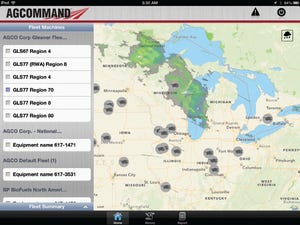 A popular feature on telematics systems that keep track of farm equipment in the field, geofencing allows the user to build a virtual fence around equipment using GPS coordinates. So when equipment leaves the fenced-in area, the telematics system sends a text message or e-mail alert. This can help avert theft, or simply let you know that your planter, sprayer or combine has finished work in a field and is moving on to the next. Similarly, telematics curfews can alert you when a machine is started after working hours.
A popular feature on telematics systems that keep track of farm equipment in the field, geofencing allows the user to build a virtual fence around equipment using GPS coordinates. So when equipment leaves the fenced-in area, the telematics system sends a text message or e-mail alert. This can help avert theft, or simply let you know that your planter, sprayer or combine has finished work in a field and is moving on to the next. Similarly, telematics curfews can alert you when a machine is started after working hours.
-David Hest
More on geofencing:
GLONASS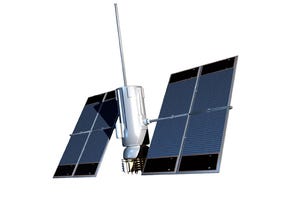 The United States’ Global Positioning System (GPS) is the big name in satellite-based navigation systems. But the Russian-built Global Orbiting Navigation Satellite System (GLONASS) is playing an increasingly important role in high-end navigation systems used in agriculture and other industries. This is because the total number of satellites visible to a navigation receiver affects accuracy. So using a navigation receiver that can access both GPS and GLONASS satellites helps assure the best possible accuracy by roughly doubling the potential number of navigation satellites that can be accessed. Receivers that can receive both GPS and GLONASS satellite signals often are called GNSS (global navigation satellite system) receivers. -David Hest
The United States’ Global Positioning System (GPS) is the big name in satellite-based navigation systems. But the Russian-built Global Orbiting Navigation Satellite System (GLONASS) is playing an increasingly important role in high-end navigation systems used in agriculture and other industries. This is because the total number of satellites visible to a navigation receiver affects accuracy. So using a navigation receiver that can access both GPS and GLONASS satellites helps assure the best possible accuracy by roughly doubling the potential number of navigation satellites that can be accessed. Receivers that can receive both GPS and GLONASS satellite signals often are called GNSS (global navigation satellite system) receivers. -David Hest
More on GLONASS:
Hybrid tractors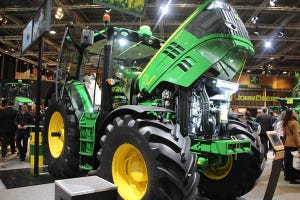 New hybrid technology, similar to that used in hybrid cars, is being used in farm vehicles to cut fuel costs while reducing harmful emissions from diesel engines. One type of hybrid technology is hydrogen power, showcased on New Holland’s NH2 prototype tractor. It is powered by a hydrogen fuel cell that runs electric motors on the tractor. New Holland Agriculture reaffirms its role as the Clean Energy Leader by announcing the release of the second-generation hydrogen-powered NH2TM tractor.
New hybrid technology, similar to that used in hybrid cars, is being used in farm vehicles to cut fuel costs while reducing harmful emissions from diesel engines. One type of hybrid technology is hydrogen power, showcased on New Holland’s NH2 prototype tractor. It is powered by a hydrogen fuel cell that runs electric motors on the tractor. New Holland Agriculture reaffirms its role as the Clean Energy Leader by announcing the release of the second-generation hydrogen-powered NH2TM tractor.
Diesel-electric hybrids are another type of hybrid where the traditional diesel engine generates power, but electric motors work in place of a standard transmission to transfer power to the ground. Four examples of these electrified platforms are the John Deere 7030 Series E-Premium tractors, the AGCO RoGator E sprayer, the Belarus Tractor International 3023 tractor, and the Rauch EDR fertilizer spreader. In testing the diesel-electric hybrids have shown a fuel savings as high as 25% over traditional diesel-powered vehicles.
This year at the SIMA show in Paris, John Deere showed a concept hybrid called the “Multifuel Tractor,” which runs on different mineral or plant fuels in a single tank. The engine is equipped with sensors that measure the properties of the fuel and make adjustments that allow it to run and also meet meet Tier 4 pollution control requirements. It is not available for sale. -Jodie Werhspann
More on hybrid tractors:
I
Insect resistance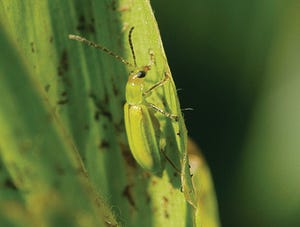 Weeds are not the only pests becoming resistant to crop protection products. Insects have joined the crowd and are showing their ability to adapt and overcome genetically enhanced traits, insecticides and plant breeding programs. Corn rootworm has developed resistance to the Bt corn trait, which targets rootworms. CRW resistance may develop in six to seven years if techniques are not used to slow it. The techniques include crop rotation; fulfilling refuge requirements for non-Bt corn; switching traits from year to year; and returning to an integrated pest management (IPM) approach rather than planting and leaving the crop alone until harvest without scouting.
Weeds are not the only pests becoming resistant to crop protection products. Insects have joined the crowd and are showing their ability to adapt and overcome genetically enhanced traits, insecticides and plant breeding programs. Corn rootworm has developed resistance to the Bt corn trait, which targets rootworms. CRW resistance may develop in six to seven years if techniques are not used to slow it. The techniques include crop rotation; fulfilling refuge requirements for non-Bt corn; switching traits from year to year; and returning to an integrated pest management (IPM) approach rather than planting and leaving the crop alone until harvest without scouting.
Insect resistance also appears in soybeans. Soybean aphids and spider mites are of particular concern because insecticide resistance has been documented for them in the Midwest. Few insecticides are on the market to control these two pests. A return to an IPM approach is also recommended to prevent insect resistance from developing further in soybeans. -John Pocock
More on insect resistance:
J, K, L
J
Joint ventures
 Agricultural companies have been teaming up for years to bring innovative products to farmers more efficiently. Here are some of the recent teams shaping the ag industry’s offerings:
Agricultural companies have been teaming up for years to bring innovative products to farmers more efficiently. Here are some of the recent teams shaping the ag industry’s offerings:
K
K, P (potassium, phosphorus)
There’s no fudging on major nutrients when top corn yields are sought. Growers need to pay close attention to potassium and phosphorus levels as well as nitrogen. As University of Illinois professor Fred Below says, it is understood that adequate levels of P and K are necessary for corn production and growers need soil tests to identify any deficiencies. Simply put, growers must pay attention to the basics as well as embrace new products and technology before achieving 300-bu. yields. -Karen McMahon
More on potassium and phosphorus:
L
Lightweight metals Aluminum, magnesium and titanium alloy shave been used for years in the aerospace and automotive industries to reduce the weight, carbon emission and fuel consumption of the structural designs. Because these lightweight materials cost more than standard steel, they’ve had limited use in agriculture. But now, as more is being learned about the harmful effects of soil compaction, the farm machinery industry is placing more emphasis on materials that lessen the weight of farm vehicles and equipment while also improving fuel economy, says Douglas Otto, engineer with CNH and program chair of the American Society of Agricultural and Biological Engineers (ASABE). “For example, some of the machines developed recently make more use of aluminum because of its strength and low weight,” Otto says. “I can’t cite anything in particular that is coming in the next year that will revolutionize the way we think about this. But those of us in the industry know that we need to move to lighter-weight materials that also carry the durability required in farming. And the price of these materials is coming down, too, making them less cost-prohibitive to use.” -Jodie Wehrspann
Aluminum, magnesium and titanium alloy shave been used for years in the aerospace and automotive industries to reduce the weight, carbon emission and fuel consumption of the structural designs. Because these lightweight materials cost more than standard steel, they’ve had limited use in agriculture. But now, as more is being learned about the harmful effects of soil compaction, the farm machinery industry is placing more emphasis on materials that lessen the weight of farm vehicles and equipment while also improving fuel economy, says Douglas Otto, engineer with CNH and program chair of the American Society of Agricultural and Biological Engineers (ASABE). “For example, some of the machines developed recently make more use of aluminum because of its strength and low weight,” Otto says. “I can’t cite anything in particular that is coming in the next year that will revolutionize the way we think about this. But those of us in the industry know that we need to move to lighter-weight materials that also carry the durability required in farming. And the price of these materials is coming down, too, making them less cost-prohibitive to use.” -Jodie Wehrspann
More on lightweight metals:
M, N, O
M
Micronutrients Farmers continue to fine-tune their crop nutrient applications beyond traditional N-P-K (nitrogen, phosphorus, potassium) fertilizer content in an effort to boost yields and incomes. Some farmers now routinely apply micronutrients as seed treatments or in starter fertilizer, near the seed, to help boost early growth and plant health.
Farmers continue to fine-tune their crop nutrient applications beyond traditional N-P-K (nitrogen, phosphorus, potassium) fertilizer content in an effort to boost yields and incomes. Some farmers now routinely apply micronutrients as seed treatments or in starter fertilizer, near the seed, to help boost early growth and plant health.
Micronutrient deficiencies vary by soil type (particularly sandy soils), pH, soil conditions and region. Combining soil test analysis with visual inspections and plant analysis is the best way to accurately determine whether any micronutrients are a limiting factor to yields in specific fields. Besides N, P, & K, possible nutrient deficiencies in corn and soybeans in various parts of the Midwest include sulfur, zinc, manganese, boron, copper, calcium, magnesium, iron, and molybdenum. -John Pocock
More on micronutrients:
N
Next-generation soybean traits High-yielding soybeans with new, herbicide- and insect-resistant traits are on their way. Monsanto hopes to make Roundup Ready 2 Xtend soybeans available in 2014. The product offers both dicamba- and glyphosate-tolerance. Monsanto is also developing several in-seed, insect protection products, and an additional, second-generation soybean product with boosted yield potential through gene insertion.
High-yielding soybeans with new, herbicide- and insect-resistant traits are on their way. Monsanto hopes to make Roundup Ready 2 Xtend soybeans available in 2014. The product offers both dicamba- and glyphosate-tolerance. Monsanto is also developing several in-seed, insect protection products, and an additional, second-generation soybean product with boosted yield potential through gene insertion.
In January, DuPont Pioneer announced the launch of its new T Series line of soybean to bring a broad range of high-yielding varieties with improved pest resistance.
In addition, Bayer CropScience and Syngenta recently submitted applications for a new soybean trait that offers tolerance to Callisto, Balance and Liberty herbicides. This trait is expected to launch between 2015 and 2020.
Dow AgroSciences announced the anticipated launch of Enlist E3 soybeans for 2015, pending U.S. and import country approvals. Enlist E3 soybeans will offer tolerance to Dow AgroSciences’ new 2,4-D product, glyphosate and glufosinate.
Many seed companies continue to work on new traits that are resistant to soybean aphids, soybean cyst nematodes, Asian soybean rust and Phytophthora root rot. -John Pocock
More on next-generation soybeans:
Nitrogen-loss protection products Nitrogen needs to be available to corn roots throughout the growing season for producing top yields and income. A number of nitrogen inhibitors, stabilizers and controlled release products are now on the market to help farmers control the release of N in the field.
Nitrogen needs to be available to corn roots throughout the growing season for producing top yields and income. A number of nitrogen inhibitors, stabilizers and controlled release products are now on the market to help farmers control the release of N in the field.
Dow AgroSciences' N-Serve has long been the industry standard for reducing N loss from anhydrous ammonia, dry ammonium and urea fertilizers. Dow AgroSciences also offers Instinct, which reduces N leaching and denitrification from urea ammonium nitrate (UAN) and liquid manure.
Other companies providing newer N-loss protection products include:
Agrium offers a controlled-released N fertilizer product, called ESN (Environmentally Smart Nitrogen). Agrotain markets three formulations (Agrotain, Agrotain Plus, and SuperU) to help reduce N loss for various N products. AgXplore International produces several N-loss reduction products, including its original product, NZone. SFP (Specialty Fertilizer Products) sells two products, NutriSphere-N and More Than Manure, to help reduce N loss in N fertilizer and manure. -John Pocock
More on nitrogen loss protection products:
Nutrient sensors Sophisticated sensors are now used to detect nutrient levels in crops for the precise application of nitrogen fertilizer. The sensors emit light onto the crop canopy and measure the amount of light reflected back to the sensor. The information is used to determine the crop's nitrogen requirements. Several companies market these sensors. Topcon Precision Agriculture sells CropSpec for liquid sprayers or granular spreaders. It is used with Topcon’s X20 console and linked to the Maplink program.
Sophisticated sensors are now used to detect nutrient levels in crops for the precise application of nitrogen fertilizer. The sensors emit light onto the crop canopy and measure the amount of light reflected back to the sensor. The information is used to determine the crop's nitrogen requirements. Several companies market these sensors. Topcon Precision Agriculture sells CropSpec for liquid sprayers or granular spreaders. It is used with Topcon’s X20 console and linked to the Maplink program.
Trimble now offers a handheld version of its GreenSeeker crop sensor that the company first released in 2009. The older system was mounted on a tractor.
The OptRx crop sensors from AgLeader may be mounted on any type of vehicle and is available for corn and wheat production. -Kathy Huting
More on nutrient sensors:
O
Ownership of farmland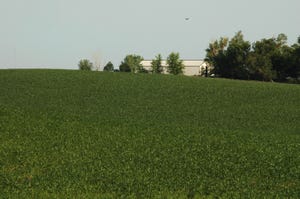 In spite of the huge rise in farmland values, the majority of farmland remains in the hands of farmers and their families. (USDA reports that less than 40% of farmland is rented.)
In spite of the huge rise in farmland values, the majority of farmland remains in the hands of farmers and their families. (USDA reports that less than 40% of farmland is rented.)
Increasingly, the owners are elderly. A 2007 Iowa State University (ISU) survey found that 28% of the state’s farmland was owned by someone older than 74 years. ISU’s Michael Duffy suggests that this does not mean more land will become available for purchase and dampen values. Instead, he speculates that the land will be transferred to families. But what happens with the next generation is the big question.
The majority of farmland sold today is purchased by farmers. In Iowa, 70% of farmland sold in 2010 was bought by farmers. In Illinois, 56% of farmland sold that year was purchased by farmers.
Foreign ownership of farmland remains minor. USDA’s Farm Service Agency reports foreign ownership of farms and forests amounts to only 1.7% of private land. -Karen McMahon
More on ownership of farmland:
P, Q, R
P
Polymers
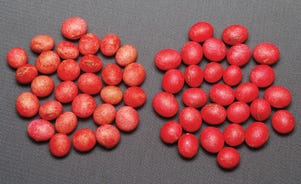 With the explosion in seed treatments and expensive seed traits, a final polymer coating on the seed makes big sense (cents). New polymer coatings are available to better preserve the seed. The polymer helps reduce dustoff from the expensive seed treatments, which in turn reduces chemical exposure to workers. The new polymers also aid flowability of seed in the increasingly more precise and expensive planters. -Karen McMahon
With the explosion in seed treatments and expensive seed traits, a final polymer coating on the seed makes big sense (cents). New polymer coatings are available to better preserve the seed. The polymer helps reduce dustoff from the expensive seed treatments, which in turn reduces chemical exposure to workers. The new polymers also aid flowability of seed in the increasingly more precise and expensive planters. -Karen McMahon
More on polymers:
Q
Quad tracks
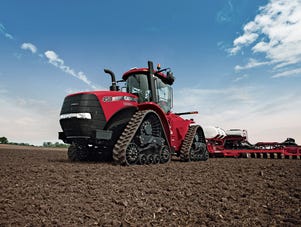 Case IH last year took the wraps off a high-hp, row-crop tractor with tracks called the Steiger Rowtrac, a takeoff of its Steiger Quadtrac four-track system. The launch of this tractor speaks to growing demand for tracks, which spread out the weight of the vehicle better than most tires can to reduce soil compaction while providing great traction and pulling power in the field.
Case IH last year took the wraps off a high-hp, row-crop tractor with tracks called the Steiger Rowtrac, a takeoff of its Steiger Quadtrac four-track system. The launch of this tractor speaks to growing demand for tracks, which spread out the weight of the vehicle better than most tires can to reduce soil compaction while providing great traction and pulling power in the field.
Other examples of tracked tractors include the original rubber-tracked AGCO Challenger, New Holland’s SmartTrax, John Deere’s RT series, and coming soon Versatile’s Delta Track, which is a story we broke last month. Tracks also are an option on other farm vehicles, including combines, planters and grain carts. -Jodie Wehrspann
More on tracks:
R
Remote integrated display access
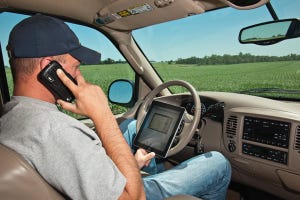 This term refers to the ability to access integrated machine displays remotely. As a result, support technicians may diagnose and fix problems without going to the field. Obviously, remote access is a huge timesaver and keeps tractors, combines and sprayers up and running when balky displays have halted field operations. Manufacturers call this capability various names, including Remote Display Access (John Deere), Remote Assistant (Trimble) and Virtual Wrench (Leica). -David Hest
This term refers to the ability to access integrated machine displays remotely. As a result, support technicians may diagnose and fix problems without going to the field. Obviously, remote access is a huge timesaver and keeps tractors, combines and sprayers up and running when balky displays have halted field operations. Manufacturers call this capability various names, including Remote Display Access (John Deere), Remote Assistant (Trimble) and Virtual Wrench (Leica). -David Hest
More on remote integrated display access:
Robots
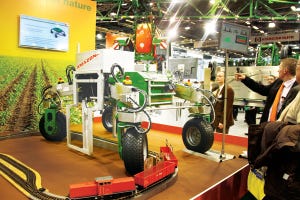 Research on robots continues to progress as engineers tackle reliability issues of the small task masters. Concept robots are nearing commercialization in Europe, though. One German robot is built to sense crop conditions, apply chemicals and even pull weeds. The University of Illinois has a similar program and students design these robotic workers. In contrast to operator-run equipment, robots are small and expected to be used in multiple numbers. -Karen McMahon
Research on robots continues to progress as engineers tackle reliability issues of the small task masters. Concept robots are nearing commercialization in Europe, though. One German robot is built to sense crop conditions, apply chemicals and even pull weeds. The University of Illinois has a similar program and students design these robotic workers. In contrast to operator-run equipment, robots are small and expected to be used in multiple numbers. -Karen McMahon
More on robots:
Renewable Fuel Standard (RFS)
 The Renewable Fuel Standard (RFS) program is good for ethanol but continues to be a contentious program among agricultural groups. RFS established the country’s first renewable fuel volume mandate in 2005 when it was created. Originally, RFS required 7.5 billion gallons of renewable fuel to be blended into gasoline by 2012. It was expanded in 2007 under the Energy Independence and Security Act (EISA). Now called RFS2, the program includes diesel (in addition to gasoline) and increased the volume of renewable fuel required to be blended into transportation fuel from 9 billion gallons in 2008 to 36 billion gallons by 2022.
The Renewable Fuel Standard (RFS) program is good for ethanol but continues to be a contentious program among agricultural groups. RFS established the country’s first renewable fuel volume mandate in 2005 when it was created. Originally, RFS required 7.5 billion gallons of renewable fuel to be blended into gasoline by 2012. It was expanded in 2007 under the Energy Independence and Security Act (EISA). Now called RFS2, the program includes diesel (in addition to gasoline) and increased the volume of renewable fuel required to be blended into transportation fuel from 9 billion gallons in 2008 to 36 billion gallons by 2022.
The goal for RFS2 is to achieve significant reductions of greenhouse gas emissions from the use of renewable fuels, reduce imported oil, and encourage development of the renewable fuels industry.
The American Petroleum Institute as well as a number of organizations in the livestock, poultry and grocery industries have sought (and continue to seek) to waive or repeal RFS. -Lynn Grooms
More on Renewable Fuel Standard:
Renewable Identification Numbers (RINs)
The Renewable Fuel Standard compliance program is based on the use of renewable identification numbers (RINs) that are assigned to batches of renewable fuel by producers and importers of those fuels. EPA developed the RIN system to ensure that biofuels are being blended by obligated parties (entities that refine, blend or import more than 10,000 gallons of gas or diesel) to meet their biomass-based diesel or ethanol volume requirements in the RFS.
RINS can be sold or traded and used by an obligated party. A RIN “moves” with the gallon of renewable fuel until it reaches the retail market or is purchased by an obligated party. A RIN is a 38-character numeric code which represents information such as renewable fuel producer, plant location, date, feedstock and so on.
In 2011, the EPA charged two companies with fraudulently producing invalid RINsearly on in the program, and individuals at those companies are now facing prison time. The National Biodiesel Board’s RIN Integrity Task Force worked with the petroleum industry to provide a solution to uncertainties in the RIN market and offered inputs into the design of the Genscape RIN Integrity Network dashboard. For information, visit genscape.com. -Lynn Grooms
More on RINs:
S, T, U
S
Social media
 The social media has gathered steam in agriculture. Groups like the U.S. Farmers and Ranchers Alliance are connecting farmers with the public and supporting conversations about food production through social media. Ag companies utilize Twitter and Facebook to push the news about their latest products to the public instantly. And individual farmers are able to share their stories in quick updates through social media with the farming community. -Kathy Huting
The social media has gathered steam in agriculture. Groups like the U.S. Farmers and Ranchers Alliance are connecting farmers with the public and supporting conversations about food production through social media. Ag companies utilize Twitter and Facebook to push the news about their latest products to the public instantly. And individual farmers are able to share their stories in quick updates through social media with the farming community. -Kathy Huting
More on social media:
Sustainability
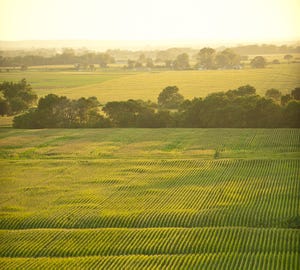 A new movement growing among ag companies and farm operators is sustainability. This term refers to all the good things about agriculture, like producing more food from less land with low environmental impact and at an economical cost. Sound difficult? Yes, but consumers are demanding it. They don’t want wasteful, harmful food production. And big companies like WalMart use sustainability as part of its successful business strategy. In the future, farm operators will need to assess the sustainability of their farm practices, with hopes that it will lead to a financial payoff. -Karen McMahon
A new movement growing among ag companies and farm operators is sustainability. This term refers to all the good things about agriculture, like producing more food from less land with low environmental impact and at an economical cost. Sound difficult? Yes, but consumers are demanding it. They don’t want wasteful, harmful food production. And big companies like WalMart use sustainability as part of its successful business strategy. In the future, farm operators will need to assess the sustainability of their farm practices, with hopes that it will lead to a financial payoff. -Karen McMahon
More on sustainability:
Supervised or semi autonomous vehicles
Although not truly robotic, since they don’t replace the need for an operator, these systems allow the navigation system on a primary vehicle to temporarily take over steering and speed-control functions from a second vehicle’s operator. The goal is to improve efficiency and safety of critical field operations. Semi-autonomous systems from John Deere (Machine Sync) and Trimble were commercially available in 2012. Both systems allow combines to take control of tractors pulling grain carts to simplify on-the-go grain transfer. When the cart is filled, the tractor operator retakes control. A supervised system introduced by Fendt in Europe, which allows a lead tractor to control a driverless tractor following behind, hints at future possibilities. -David Hest
More on supervised/semi-autonomous:
T
Telematics
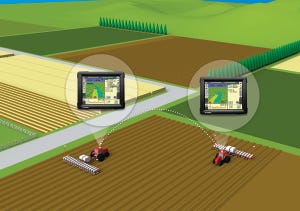 Telematic systems use cellular modems to monitor machine performance and keep track of equipment in the field in real time. Increasingly, telematics systems are being offered as standard equipment on tractors, combines and sprayers as manufacturers look for ways to help customers boost efficiency and improve customer service and reduce warranty costs. Typically, telematics systems allow operators to monitor equipment locations in real time, as well as access a history of previous locations. They also record machine performance data and alert owners and/or dealers when problems occur. -David Hest
Telematic systems use cellular modems to monitor machine performance and keep track of equipment in the field in real time. Increasingly, telematics systems are being offered as standard equipment on tractors, combines and sprayers as manufacturers look for ways to help customers boost efficiency and improve customer service and reduce warranty costs. Typically, telematics systems allow operators to monitor equipment locations in real time, as well as access a history of previous locations. They also record machine performance data and alert owners and/or dealers when problems occur. -David Hest
More on telematics:
U
Unmanned aerial vehicle (UAV) or Drones
Commonly known as drones, UAVs could become a low-cost precision ag scouting tool in the not-too-distant future. As electronics and communications device prices have fallen, companies catering to hobbyists have begun selling small fixed-wing and helicopter drones for as little as $500. These UAVs, which can be programmed to follow designated flight paths, are legal to operate as long as visual contact is maintained and altitude limits are followed. Already, a UAV manufacturer, DIY Drones (diydrones.com), has promised to introduce a helicopter with optics needed for crop scouting by the end of 2013. It is expected to have a price tag of under $1,000. Other UAVs, like the WineHawk platform (winehawklabs.com), though priced higher, produce precise and consistent results. These systems, that use hands-off intelligence, take away the manual process that can degrade data. Currently, commercial use in the U.S. is prohibited. However, Federal Aviation Administration (FAA) rules are expected to change in 2015 as the agency fulfills direction from Congress to begin allowing commercial use. - David Hest
More on drones:
V, W, X, Y, Z
V
Variable-rate irrigation (VRI)
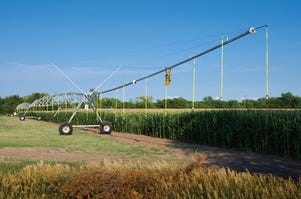 Irrigation has become a bigger part of Midwest farming, especially in drought years like 2012. New technologies are making the practice more precise to conserve water and boost crop yields. Big-name manufacturing companies, such as Valmont, Reinke, and T-L Irrigation have come out with variable-rate-irrigation (VRI) equipment that automatically applies just the right amount of water to areas of a field that need it most. Rates are pre-programmed or “prescribed” based on field characteristics such as soil type, topography, and crops planted. For example, Valley Irrigation this year added QuickStart (QS) prescription writing to its Variable Rate Irrigation (VRI) product, allowing growers to customize their water application throughout their field.
Irrigation has become a bigger part of Midwest farming, especially in drought years like 2012. New technologies are making the practice more precise to conserve water and boost crop yields. Big-name manufacturing companies, such as Valmont, Reinke, and T-L Irrigation have come out with variable-rate-irrigation (VRI) equipment that automatically applies just the right amount of water to areas of a field that need it most. Rates are pre-programmed or “prescribed” based on field characteristics such as soil type, topography, and crops planted. For example, Valley Irrigation this year added QuickStart (QS) prescription writing to its Variable Rate Irrigation (VRI) product, allowing growers to customize their water application throughout their field.
Reinke Mfg. partnered CropMetrics, a data management company, this year to offers Sector VRI and Zone VRI, which allows for varying the speed of the irrigation system and turning on and off individual sprinklers.(Photo cutline: Reinke VRI prescription layers)
New web-based programs make it possible to control and monitor the equipment remotely from their mobile device or laptop using web-based programs such as Valmont’s Valley VRI system. Reinke variable rate irrigation (VRI) is now available for growers. -Jodie Wehrspann
More on variable-rate irrigation:
W
Weed resistance management
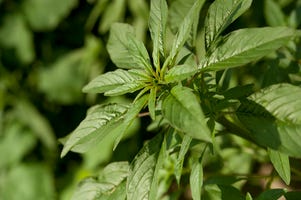 More than 20 different types of herbicide-resistant weeds now exist in Illinois and Iowa and nearly as many in surrounding Midwest states. Weed resistance has grown from a lambsquarters resistance to atrazine confirmed in Illinois and kochia resistance to atrazine confirmed in Iowa, both in 1985, to the high level of resistance today. Common waterhemp is the most prevalent herbicide-resistant weed in Illinois with Palmer amaranth quickly catching up. In Iowa, horseweed is the most widespread herbicide-resistant weed. Horseweed’s resistance to glyphosate in 2011 is the most recently confirmed case found in Iowa.
More than 20 different types of herbicide-resistant weeds now exist in Illinois and Iowa and nearly as many in surrounding Midwest states. Weed resistance has grown from a lambsquarters resistance to atrazine confirmed in Illinois and kochia resistance to atrazine confirmed in Iowa, both in 1985, to the high level of resistance today. Common waterhemp is the most prevalent herbicide-resistant weed in Illinois with Palmer amaranth quickly catching up. In Iowa, horseweed is the most widespread herbicide-resistant weed. Horseweed’s resistance to glyphosate in 2011 is the most recently confirmed case found in Iowa.
The keys to battling herbicide-resistant weeds include a focus on early-season control; use of a pre-emergence herbicide at planting; selecting the right herbicide for the right weed at the right time; early post-emergence applications with follow-up, if needed; and diversification of herbicide sites of action. Cover crops and crop rotation are also commonly recommended practices. -John Pocock
More on weed resistance management:
XYZ
Youtube
From the "I'm Farming and I Grow it" video adaptation by the Peterson brothers that raked in over 8 million views, to technical how-to videos from the major agriculture company representatives explaining their newest technologies, farmers have found many ways to connect to the farming community through YouTube. The online video sharing website was just barely starting to become popular with the public the last time we published the A to Z list in 2008. -Kathy Huting
About the Author(s)
You May Also Like










